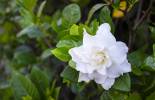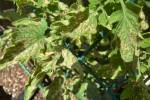Dose of nitrogen important for lawns
I want to give a quick reminder to those of you with lawns. If you have a cool-season lawn, such as fescue or overseeded Bermudagrass, then give your lawn an application of nitrogen fertilizer right about now. This can be just straight nitrogen, such as ammonium sulfate, and does not have to be a high-priced fertilizer.
However if you have been using just plain old nitrogen on your lawn this past season, then go ahead and put on a good quality fertilizer now. This high nitrogen is important in keeping the lawn dark green during the winter months when temperatures get below 20 F.
Q: Can a persimmon tree grow well in the Henderson area? Please advise.
A: Persimmons will grow here, but select a variety other than Hachiya since it does not seem that productive here. The fruit gets about the size of a quarter and then drops off of the tree. It isn't just our climate, it does the same thing elsewhere. We have tried several things to improve fruit retention but none have worked so far.
The most solid bet for persimmons here is Fuyu. It is nonastringent, which means you can eat it without any puckering. Fuyu has been productive for 17 years in a row here but the exposed fruit does suffer from sunburn.
Varieties that have shown some promise also include Giant Fuyu, Chocolate and Coffeecake, which, after two years of production, I like a lot but still want to see it for at least another year before I recommend it.
It is best if persimmon is located in an area of the yard that is protected from late afternoon sun but still gets at least six to eight hours of light each day during the time of production. Persimmon does like compost and a fairly rich soil so that is a good spot to put your coffee grounds and kitchen compost as well as a nice thick layer of wood mulch.
Q: I attached photos of my sick palm. It is getting plenty of water and my other two palms are doing fine. It looks like there are webs around where the berries are, but they are not growing. Do you have any ideas how I can save my palm?
A: The picture marked No. 4 that you sent to me is the most troubling. It looks like the central fronds or frond is brown or dead. From the picture, it appears to be a windmill palm. The windmill palm has only one central trunk or stem but has a hairy trunk like yours in the picture.
The only other palm tree that grows here and has a hairy trunk is the Mediterranean fan palm, but it has multiple trunks, not a single trunk, unless you keep the side trunks pruned out.
If the center bud of the palm tree died, then the entire tree is dead. As the palm tree gets older, it will just die because the central bud is gone. If I'm wrong about the picture and the central bud is not dead but the fronds are damaged, then it could be alive.
I am not very concerned about the webbing. Most web-spinning spiders are good guys. If this is the case, wash all of the old flowers and the webbing with soap and water spray or cut off the dead flowers just like you would if it were a frond.
Trim out the dead fronds as close to the trunk as possible. Make sure the palm tree is getting deep watered just like any other tree and is not being watered too frequently. Fertilize like you would any ornamental tree in early February. The hairy trunk or fuzzy trunk is normal.
Q: I vividly recall while living in Minnesota, we would soak our bare root trees in a liquid mixture of starting fertilizer for a few days before planting. However this is Nevada and a lot of my old tricks have so far resulted in failure. My "need to know" level is becoming more urgent as I deal with my frustrations. One of your study groups might find a place in reducing some of these frustrations.
A: Soaking the roots is still a good "trick." The only difference is you should not let them soak for more than a few hours. Sometimes people say to soak the roots overnight. This could be a mistake if the water and air temperatures are warm.
Soaking the roots in cold or very cool water in cool or colder temperatures (not freezing) will be good for the tree before planting. The roots must survive in water that has air in it and the air or oxygen can be depleted fairly quickly if the water or air temperatures are too warm.
In warm water, oxygen depletion can happen fast and may cause root damage or death. So soak them for only a couple of hours prior to planting. It can have a mild fertilizer solution in it if you want, but the fertilizer should also be in the backfill soil.
By the way, soaking for a couple of hours works well for garlic cloves and sweet corn, any large seed or propagule, before planting. When you are a backyard gardener or small-scale producer, working with wet seed is not a big problem and can cut off days in the germination process.
Imbibing the seed (letting it soak up water) with a weak fertilizer solution also can also be a good little trick to use to speed germination. If you are a good gardener, you can even let the seed dry on the outside of the seed coat before planting. The trick is not to let it dry too much and kill the seed, but still have the seed "plump" with water when planting.
Bob Morris is a horticulture expert living in Las Vegas. Visit his blog at xtremehorticulture.blogspot.com.





























